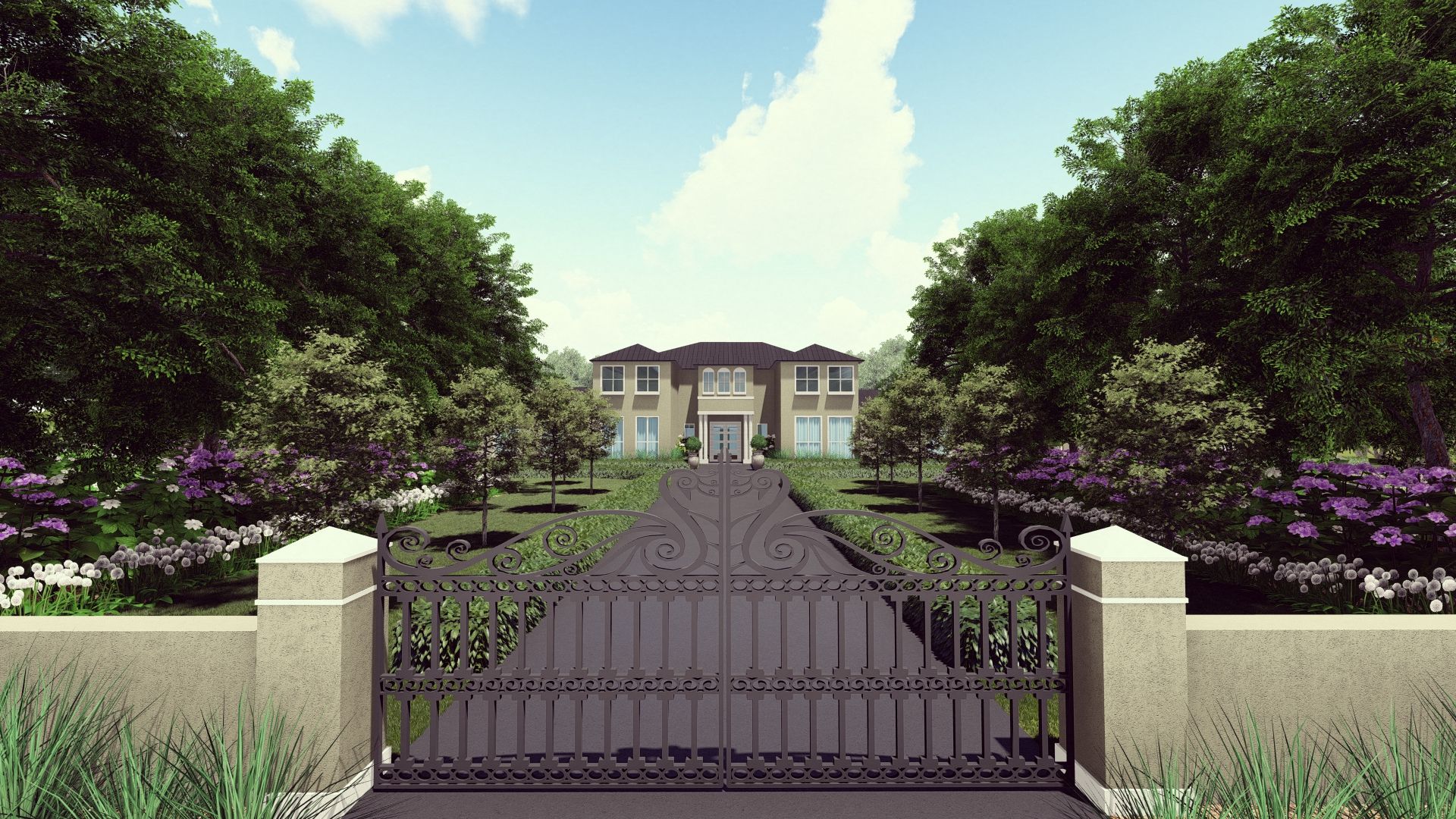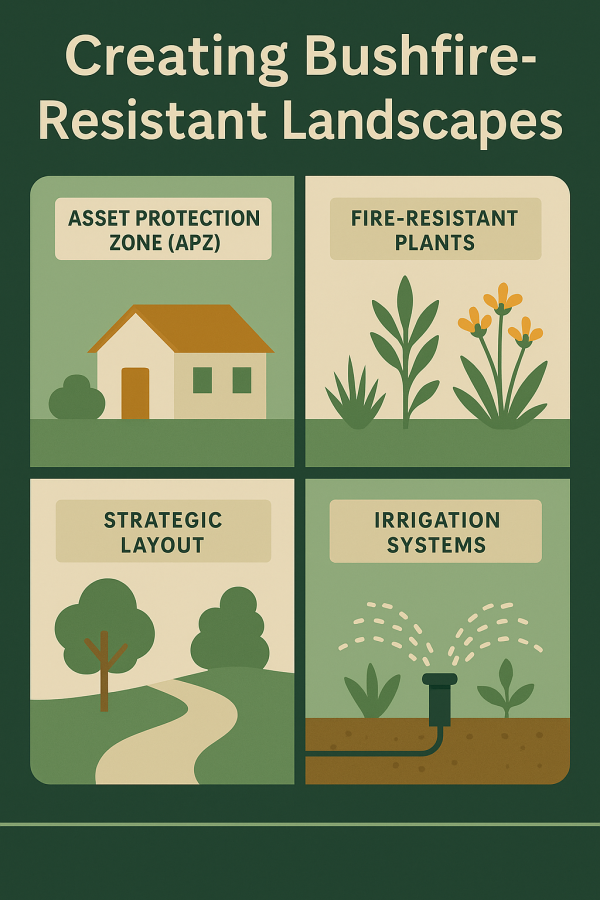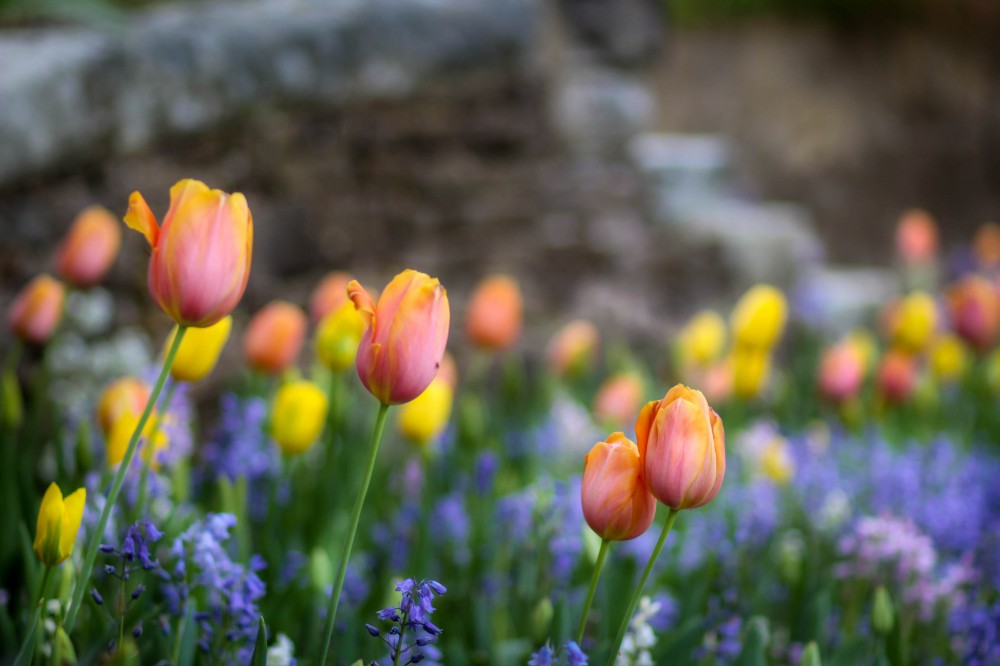With the increasing frequency and intensity of bushfires across New South Wales—especially in the Blue Mountains, Hawkesbury, and Sydney’s Northern Suburbs—homeowners and developers are rethinking residential landscape design.
A garden can act as a protective buffer or a dangerous fuel source, depending on how it’s designed.
At Dapple Landscape Design, our team of qualified professionals delivers bushfire-compliant landscape plans that balance aesthetics, lifestyle, and safety.
This guide explores the essential components of bushfire-resistant landscaping in NSW, including compliance with BAL assessments, fire-smart materials, water systems, and planting strategies.

Understanding Bushfire Attack Levels (BAL) and Site Constraints
In NSW, new homes or substantial renovations in bushfire-prone areas must comply with Planning for Bushfire Protection and AS3959:2018. Central to this is the Bushfire Attack Level (BAL) rating, which categorises risk from BAL-LOW (minimal) to BAL-FZ (Flame Zone).
Designs must respond to:
-
Proximity of vegetation
-
Slope and wind direction
-
Ember exposure potential
Our landscape design service in the Blue Mountains routinely addresses complex BAL compliance requirements for both residential and DA-approved developments.
Asset Protection Zones (APZs)
The Asset Protection Zone is a critical buffer designed to slow or stop the spread of fire. According to the NSW Rural Fire Service, the APZ:
-
Must extend 20–100m depending on vegetation and slope
-
Should include open, maintained areas (lawns, paving)
-
Requires ongoing removal of fine fuels like leaves and twigs
Dapple often designs low-flammability buffer zones using non-combustible paving, gravel, and stone in the inner 10m of a home.
Fire-Resistant Plant Selection
Fire-retardant does not mean fire-proof, but the right plant choices significantly reduce risks.
Recommended Low-Flammability Native Plants:
|
|
|
||||||
|
|
|
||||||
|
|
|
||||||
|
|
|
||||||
|
|
|
||||||
|
|
|
For clients in Northern Beaches or the North Shore of Sydney, we adapt species to suit microclimates, proximity to salt air, and slope orientation. See our North Shore design services for more info.
Design Strategies for Ember Control and Radiant Heat Reduction
Designing bushfire-smart gardens means interrupting fuel paths and minimising ember entry points.
Technical Layout Tips:
-
Use gravel paths and stone walls to separate planting zones
-
Avoid dense hedges beneath windows or near decks
-
Use tiered planting with gaps between groundcover, shrubs, and trees
-
Install non-flammable barriers such as corten steel or masonry
Strategically placed courtyards, pergolas, and retaining walls can redirect radiant heat and provide essential firebreaks.

Fire-Rated Materials and Construction
Fire-safe materials are essential for hardscaping, especially near structures.
Recommended Hardscape Elements:
|
Avoid pine bark mulch and timber retaining walls unless rated or treated. We provide guidance on product selection for all hardscape features.
Irrigation and Passive Water Systems
Drought conditions dry out soil and plants, raising the fire risk. A resilient garden must remain hydrated.
Technical Watering Solutions:
-
Dripline irrigation with anti-clog and pressure-compensated emitters
-
Rainwater tanks connected to the garden and hose reels
-
Soil moisture sensors for smart controller systems
-
Passive design elements like swales, bioswales, and rain gardens
These features are seamlessly integrated into our eco-sensitive garden design services, ensuring gardens support resilience without wasting water.
Soil Retention and Topographic Design
Fire-damaged soils often become hydrophobic, causing poor infiltration and erosion. This is especially important in sloped areas like the Blue Mountains and Hawkesbury.
Soil Engineering Techniques:
-
Biochar-infused soils for improved water-holding and carbon sequestration
-
Use of geotextile fabrics for slope stabilisation
-
Incorporation of soil cells and subsurface drainage to prevent runoff
-
Contour mapping to direct water away from buildings and into plantings
These design elements are critical for properties in BAL-29 or higher, particularly on ridgelines or exposed valleys.
Seasonal Maintenance for Fire Preparedness
Maintenance is essential. A well-designed but neglected landscape can become a fire hazard.
Key Tasks:
|
Work With Dapple Landscape Design
Whether you need a DA-compliant landscape plan or a complete garden redesign, Dapple’s team combines creative expertise with technical precision. We work closely with architects, certifiers, and councils to create bushfire-resilient outdoor spaces for homes across:
-
Northern Beaches
Let us help you future-proof your property while enhancing its beauty and livability.
FAQs
Q1: What is the safest mulch for bushfire-prone areas?
Use gravel, crushed rock, or composted fine mulch under 2mm. Avoid bark-based and pine mulch.
Q2: Can I use succulents in bushfire zones?
Yes. Succulents like pigface retain water and have minimal combustible oils, making them excellent choices.
Q3: Do I need approval for bushfire-resistant landscaping?
Yes, in BAL-rated zones, landscape plans often form part of the DA process. We provide DA-ready plans.
Q4: Are native plants always fire-safe?
No. Some natives (like eucalypts) have high oil content. Selection must be made based on flammability traits, not just nativity.
Q5: How often should I maintain a fire-resistant garden?
Quarterly maintenance is recommended, especially leading into bushfire season (Sept–March).
Want Expert Help?
Contact Dapple Landscape Design today to discuss how we can create a bushfire-resilient landscape for your home or development. Our expert team proudly serves clients across Sydney, the Blue Mountains, and surrounding bushfire-prone zones.
